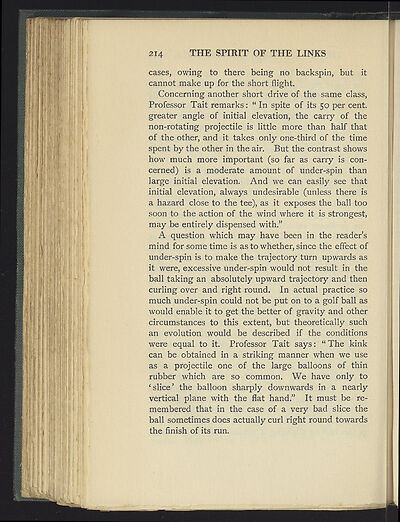Spirit of the links
(226)
Download files
Complete book:
Individual page:
Thumbnail gallery: Grid view | List view

cases, owing to there being no backspin, but it
cannot make up for the short flight.
Concerning another short drive of the same class,
Professor Tait remarks: " In spite of its
50
per cent.
greater angle of initial elevation, the carry of the
non-rotating projectile is little more than half that
of the other, and it takes only one-third of the time
spent by the other in the air. But the contrast shows
how much more important (so far as carry is con-
cerned) is a moderate amount of under-spin than
large initial elevation. And we can easily see that
initial elevation, always undesirable (unless there is
a hazard close to the tee), as it exposes the ball too
soon to the action of the wind where it is strongest,
may be entirely dispensed with."
A question which may have been in the reader's
mind for some time is as to whether, since the effect of
under-spin is to make the trajectory turn upwards as
it were, excessive under-spin would not result in the
ball taking an absolutely upward trajectory and then
curling over and right round. In actual practice so
much under-spin could not be put on to a golf ball as
would enable it to get the better of gravity and other
circumstances to this extent, but theoretically such
an evolution would be described if the conditions
were equal to it. Professor Tait says: " The kink
can be obtained in a striking manner when we use
as a projectile one of the large balloons of thin
rubber which are so common. We have only to
slice' the balloon sharply downwards in a nearly
vertical plane with the flat hand." It must be re-
membered that in the case of a very bad slice the
ball sometimes does actually curl right round towards
the finish of its run.
cannot make up for the short flight.
Concerning another short drive of the same class,
Professor Tait remarks: " In spite of its
50
per cent.
greater angle of initial elevation, the carry of the
non-rotating projectile is little more than half that
of the other, and it takes only one-third of the time
spent by the other in the air. But the contrast shows
how much more important (so far as carry is con-
cerned) is a moderate amount of under-spin than
large initial elevation. And we can easily see that
initial elevation, always undesirable (unless there is
a hazard close to the tee), as it exposes the ball too
soon to the action of the wind where it is strongest,
may be entirely dispensed with."
A question which may have been in the reader's
mind for some time is as to whether, since the effect of
under-spin is to make the trajectory turn upwards as
it were, excessive under-spin would not result in the
ball taking an absolutely upward trajectory and then
curling over and right round. In actual practice so
much under-spin could not be put on to a golf ball as
would enable it to get the better of gravity and other
circumstances to this extent, but theoretically such
an evolution would be described if the conditions
were equal to it. Professor Tait says: " The kink
can be obtained in a striking manner when we use
as a projectile one of the large balloons of thin
rubber which are so common. We have only to
slice' the balloon sharply downwards in a nearly
vertical plane with the flat hand." It must be re-
membered that in the case of a very bad slice the
ball sometimes does actually curl right round towards
the finish of its run.
Set display mode to:
![]() Universal Viewer |
Universal Viewer | ![]() Mirador |
Large image | Transcription
Mirador |
Large image | Transcription
Images and transcriptions on this page, including medium image downloads, may be used under the Creative Commons Attribution 4.0 International Licence unless otherwise stated. ![]()
| Sports publications > Spirit of the links > (226) |
|---|
| Permanent URL | https://digital.nls.uk/231654139 |
|---|
| Description | More than 230 sports publications from the National Library of Scotland's collections. Featured sports include football, rugby, golf, shinty, athletics, bowls, cricket and hockey. Among the material from the late 19th and early 20th centuries are match programmes, club histories, and handbooks. From the late 20th century are promotional materials to encourage greater diversity in sport. Most items cover sports activities in Scotland. There are also publications relating to the Olympics and international matches. |
|---|---|
| Additional NLS resources: |
|

